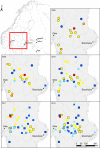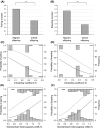Genetic rescue in a severely inbred wolf population
- PMID: 27497431
- PMCID: PMC5054837
- DOI: 10.1111/mec.13797
Genetic rescue in a severely inbred wolf population
Abstract
Natural populations are becoming increasingly fragmented which is expected to affect their viability due to inbreeding depression, reduced genetic diversity and increased sensitivity to demographic and environmental stochasticity. In small and highly inbred populations, the introduction of only a few immigrants may increase vital rates significantly. However, very few studies have quantified the long-term success of immigrants and inbred individuals in natural populations. Following an episode of natural immigration to the isolated, severely inbred Scandinavian wolf (Canis lupus) population, we demonstrate significantly higher pairing and breeding success for offspring to immigrants compared to offspring from native, inbred pairs. We argue that inbreeding depression is the underlying mechanism for the profound difference in breeding success. Highly inbred wolves may have lower survival during natal dispersal as well as competitive disadvantage to find a partner. Our study is one of the first to quantify and compare the reproductive success of first-generation offspring from migrants vs. native, inbred individuals in a natural population. Indeed, our data demonstrate the profound impact single immigrants can have in small, inbred populations, and represent one of very few documented cases of genetic rescue in a population of large carnivores.
Keywords: Canis lupus; genetic rescue; heterozygosity; immigration; inbreeding; inbreeding depression.
© 2016 The Authors. Molecular Ecology Published by John Wiley & Sons Ltd.
Figures




References
-
- Alf EF, Grossberg JM (1979) Geometric mean ‐ confidence‐limits and significance tests. Perception and Psychophysics, 26, 419–421.
-
- Boakes EH, Wang J, Amos W (2007) An investigation of inbreeding depression and purging in captive pedigreed populations. Heredity, 98, 172–182. - PubMed
-
- Buckland ST, Burnham KP, Augustin NH (1997) Model selection: an integral part of inference. Biometrics, 53, 603–618.
MeSH terms
Associated data
LinkOut - more resources
Full Text Sources
Other Literature Sources
Molecular Biology Databases

